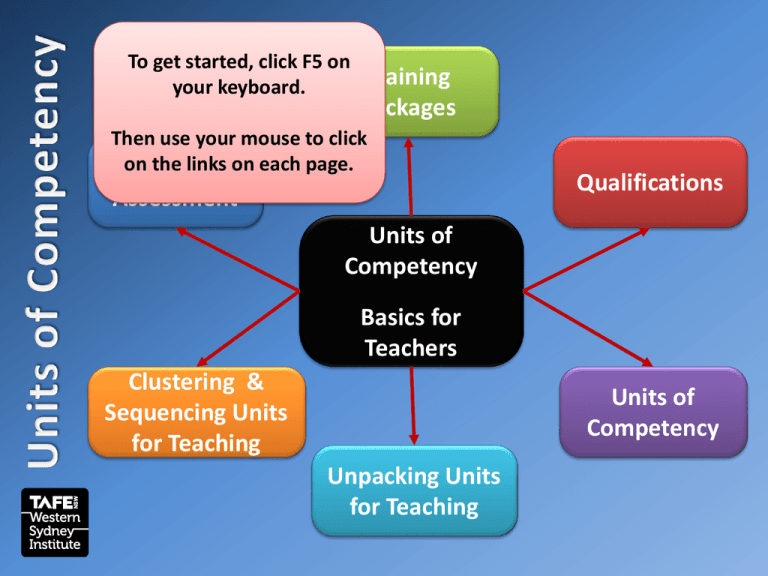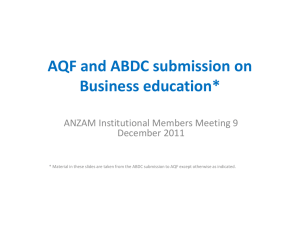Understanding Units of Competency Basics
advertisement

To get started, click F5 on Training your keyboard. Packages Then use your mouse to click on the links Delivery andon each page. Assessment Qualifications Units of Competency Basics for Teachers Clustering & Sequencing Units for Teaching Units of Competency Unpacking Units for Teaching Training Packages Training Packages are made up of: • Competency standards • Assessment guidelines • National qualifications The details of all Training Packages are available on the National Training Information Website: www.ntis.gov.au. Click The national system of qualifications enables students and qualified workers to move interstate without having to “re-qualify”. to see more information A Training Package TP is a set of nationally endorsed standards and nationally recognised qualifications used to develop and assess skills and knowledge people need to perform effectively in the workplace. Training Packages are developed by Industry via Industry Skills Councils (ISCs). Training Packages Training Packages are made up of: • Competency standards • Assessment guidelines • National qualifications A Training Package TP is a set of nationally endorsed standards and nationally There are 11 Industry Skills Councils recognised established by government to: qualifications to develop and assess • Provide accurate used industry skills and knowledge information to the Vocational people(VET) needsector to perform Education and Training in the • Develop Training effectively Packages that workplace. reflect industry needs for industry and the VET sector. The Industry Skills Councils have a The details of all Training rolling program of updating and Packages are Training availablePackages on improving on a the National basis. Training continuing Information Website: You can find a list of the status of www.ntis.gov.au. Training Packages at the Training Packages @ Work website. The national system of qualifications enables students and qualified workers to move interstate without having to “re-qualify”. Training Packages are developed by Industry via Industry Skills Councils (ISCs). Training Packages Training Packages are made up of: • The Competency standards National Training Information • Service Assessment guidelines website that is a government of the details of current • contains Nationalall qualifications and obsolete Training Packages (TPs). Click the link below to go to the NTIS website. The details of all Training Packages are available on the National Training Information Website: www.ntis.gov.au. A Training Package TP is a set of nationally endorsed standards and nationally recognised qualifications used to develop and assess skills and knowledge people need to perform effectively in the workplace. From the NTIS website you can search for and view or download: • The qualifications within the TP The rules prescribing the The•national system of combination qualifications enablesof units for each qualification (called theTraining Packages are students and qualified workers to move rules). packaging developed by interstate without having • Details of every Unit of Industry via Industry to “re-qualify”. Skills Councils (ISCs). Competency in the TP • Assessment guidelines for VET assessors. The logo used by RTOs to indicate that a qualification is part of the AQF. Qualifications The requirements for issuing a Training Package (TP) qualification are specified in the TP “Packaging Rules”. Click for more info: National VET qualifications can only be issued by Registered Training Organisations (RTOs). RTOs must have each qualification on their “scope of registration” . TAFE Institutes tend to have a wide range of qualifications on their scope. The Australian Qualifications Framework (AQF) provides a comprehensive, nationally consistent framework for all post-compulsory education and training. For the VET sector the qualifications are: • Certificate I - AQF1 • Certificate II - AQF2 • Certificate III - AQF3 • Certificate IV - AQF4 • Diploma - AQF5 • Advanced Diploma - AQF6 For people with a degree or equivalent: • Vocational Graduate Certificate • Vocational Graduate Diploma A Statement of Attainment can be issued for completed units that don’t add up to a full qualification. Click to see how the TP & unit codes work. Qualifications Each AQF level of qualification has distinguishing features. These are set out in table in the AQF Handbook. Trade courses (such as plumber and hairdresser) are set at Certificate III. Para-professional courses are at Diploma and Adv Diploma. AQF Level AQF 1 Certificate I AQF 2 Certificate II AQF 3 Certificate III AQF 4 Certificate IV This table might help you to interpret the skills and knowledge students might need at different AQF levels. AQF 5 & 6 Diploma and Advanced Dilpoma “Doing words” that begin units of competency at this AQF level Follow .... Apply ..... Operate basic ..... Prepare ..... Implement ..... Produce ..... Operate ..... Deliver ..... Monitor ..... Supervise ..... Write simple ..... Exercise initiative Develop ..... Coordinate ..... Write complex ..... Supervise ....... Analyse ..... Design ..... Manage ..... Plan and coordinate ..... Evaluate ..... Units of Competency A Unit of Competency (UoC) describes the skills and knowledge required to competently perform a work task. It is the smallest entity that can be awarded and recognised in a qualification. Units of competency follow a standard format to enable you to find the information you are after. This format is described in this table. Unit Code Unit Title Click on the to see an example of each Combination of letters and numbers that conform to a standard The title should give a description of the work function Unit descriptor This expands on the unit title, describing the work function. Application of the Unit This fleshes out the scope, purpose and operation of the UoC in different contexts. Elements These describe the skill outcomes that contribute to a UoC Performance Criteria These specify the required level of performance and are expressed as a standard. The skills and knowledge required to perform effectively in the workplace Required skills and knowledge Range Statement Evidence Guide Provides details of the work context and conditions in which the skills apply. The skills and knowledge that must be demonstrated to prove competence An extract from the Financial Services Training Package – code FNS10 Units of Competency FNSACC405A Unit Code Maintain inventory records Unit Title This unit describes the performance outcomes, skills and knowledge required to comply with organisational inventory procedures, reconcile inventory records to general ledgers, record inventory flows, prepare schedules and produce ad hoc reports. Back Click here to learn about the TP & unit coding system. Combination of letters and numbers that conform to a standard The title should give a description of the work function Unit descriptor This expands on the unit title, describing the work function. Application of the Unit This fleshes out the scope, purpose and operation of the UoC in different contexts. Elements These describe the skill outcomes that contribute to a UoC Performance Criteria These specify the required level of performance and are expressed as a standard. The skills and knowledge required to perform effectively in the workplace Required skills and knowledge Range Statement Evidence Guide Provides details of the work context and conditions in which the skills apply. The skills and knowledge that must be demonstrated to prove competence An extract from the Financial Services Training Package – code FNS10 FNSACC405A Maintain inventory records This Unit can be applied across all sectors within the financial services sector. Unit sector: Accounting Back Units of Competency Unit Code Unit Title Click on the to see an example of each Combination of letters and numbers that conform to a standard The title should give a description of the work function Unit descriptor This expands on the unit title, describing the work function. Application of the Unit This fleshes out the scope, purpose and operation of the UoC in different contexts. Elements These describe the skill outcomes that contribute to a UoC Performance Criteria These specify the required level of performance and are expressed as a standard. The skills and knowledge required to perform effectively in the workplace Required skills and knowledge Range Statement Evidence Guide Provides details of the work context and conditions in which the skills apply. The skills and knowledge that must be demonstrated to prove competence An extract from the Financial Services Training Package – code FNS10 FNSACC405A Maintain inventory records 1. Process inventory purchase 2. Record inventory flows 3. Reconcile inventory records to general ledgers 4. Prepare inventory schedules and ad hoc reports Back Units of Competency Unit Code Unit Title Click on the to see an example of each Combination of letters and numbers that conform to a standard The title should give a description of the work function Unit descriptor This expands on the unit title, describing the work function. Application of the Unit This fleshes out the scope, purpose and operation of the UoC in different contexts. Elements These describe the skill outcomes that contribute to a UoC Performance Criteria These specify the required level of performance and are expressed as a standard. The skills and knowledge required to perform effectively in the workplace Required skills and knowledge Range Statement Evidence Guide Provides details of the work context and conditions in which the skills apply. The skills and knowledge that must be demonstrated to prove competence An extract from the Financial Services Training Package – code FNS10 FNSACC405A Maintain inventory records 1. Process inventory purchase 1. Purchase of inventory is recorded from appropriate documentation ...... 2. Periodic and perpetual records of inventory are applied as appropriate. 2. Record inventory flows 1. Inventory flow assumptions are applied as appropriate. 2. Inventory is valued using appropriate validation rules And so on for elements 3 & 4. Back Units of Competency Unit Code Unit Title Unit descriptor Click on the to see an example of each Combination of letters and numbers that conform to a standard The title should give a description Element of the work function This expands on the unit title, describing the work function. Performance criteria This fleshes out the scope, purpose and Application of the Unit operation of the UoC in different contexts. Elements These describe the skill outcomes that contribute to a UoC Performance Criteria For each element, these specify the required level of performance and are expressed as a standard. The skills and knowledge required to perform effectively in the workplace Required skills and knowledge Range Statement Evidence Guide Provides details of the work context and conditions in which the skills apply. The skills and knowledge that must be demonstrated to prove competence An extract from the Financial Services Training Package – code FNS10 FNSACC405A Maintain inventory records Required skills 1. Communications skills to : • Determine and confirm work requirements, using questioning .... • Liaise with others, share info, listen and understand • Use language and concepts ...... 2. Research skills such as accessing & managing info; interpreting documentation. 3. Numeracy and IT skills such as: • Calculating financial ratios & related information • Accessing and using software such as spreadsheets and databases. And so on Back Units of Competency Unit Code Combination of letters and numbers that conform to a standard Unit Title Required The titleknowledge should give a description the work function 1. ofBanking processes Unit descriptor2. This expands the unitdata title, describing Process foron entering the work function. into general ledgers Inventory valuation rules Application of 3. This fleshes out the scope, purpose and the Unit of the UoC in different contexts. 4. operation Reconciliation processes Spreadsheet functions describe the skill outcomes that Elements 5. These contribute to a UoC Performance Criteria Required skills and knowledge Range Statement Evidence Guide For each element, these specify the required level of performance and are expressed as a standard. The skills and knowledge required to perform effectively in the workplace Provides details of the work context and conditions in which the skills apply. The skills and knowledge that must be demonstrated to prove competence An extract from the Financial Services Training Package – code FNS10 FNSACC405A Maintain inventory records Units of Competency Unit Code Unit Title 1. Documentation may include: • • • Delivery reports Invoices from suppliers Purchase orders 2. Inventory flow assumptions may include: • • • Calculations based on gross margins Cost Net realisable value 3. Inventory valuation rules may include: • • First in , firs out Specific identification Back Click on the to see an example of each Combination of letters and numbers that conform to a standard The title should give a description of the work function Unit descriptor This expands on the unit title, describing the work function. Application of the Unit This fleshes out the scope, purpose and operation of the UoC in different contexts. Elements These describe the skill outcomes that contribute to a UoC Performance Criteria These specify the required level of performance and are expressed as a standard. The skills and knowledge required to perform effectively in the workplace Required skills and knowledge Range Statement Evidence Guide Provides details of the work context and conditions in which the skills apply. The skills and knowledge that must be demonstrated to prove competence An extract from the Financial Services Training Package – code FNS10 FNSACC405A Maintain inventory records Units of Competency Unit Code Unit Title Critical aspects for assessment and evidence required to demonstrate competency in this unit: Evidence of the ability to: • Interpret and apply organisational policies and procedures and inventory validation rules • Make inventory flow assumptions and record inventory flows • Context of and specific resources for assessment • Method of assessment Back Combination of letters and numbers that conform to a standard The title should give a description of the work function Unit descriptor This expands on the unit title, describing the work function. Application of the Unit This fleshes out the scope, purpose and operation of the UoC in different contexts. Elements These describe the skill outcomes that contribute to a UoC Performance Criteria These specify the required level of performance and are expressed as a standard. The skills and knowledge required to perform effectively in the workplace • Prepare schedules and ad hoc reports Also contains detailed info about: Click on the to see an example of each Required skills and knowledge Range Statement Evidence Guide Provides details of the work context and conditions in which the skills apply. The skills and knowledge that must be demonstrated to prove competence Units of Competency Training Package Code 3 letters and 2 numbers Industry Year of endorsement Examples: • FNS10 – Financial Services, endorsed in 2010 • TAA04 – Training & Assessment, endorsed 2004 • CHC08 – Community Services, endorsed 2008 Qualification Code 3 letters and 5 numbers Industry AQF level of qual (1) + number of the qual (2) + year of endorsement of TP (2) Examples: • TAA40104 – Cert IV in Training & Assessment, TP of 2004 • BSB51207 – Diploma of Marketing, TP of 2007 • MEM30205 – Cert III in Engineering – Mechanical Trade, TP of 2005 Unit of Competency Code 3 letters, letters, numbers, 1 letter Industry Sector Unit number – may indicate AQF level Back to Qualifications Version – A, B, C ... Examples: • FNSACC405A – Financial Services – Accounting – in AQF4 courses – unit 05 – Version A • ICAD3218B – Info Technology – Documentation – in Cert III courses – unit 218 – Version B Note: Some UoCs do not follow this pattern, although they all start with the industry code and end with Version letter. Unpacking Units for Teaching Thoroughly read through the units that make up the qualification you are teaching. Relate to your experience of this type of work. Visualise what it means to be competent to perform this work. Review the level of the AQF qualification. See the section on Qualifications in this presentation. Make sure that your interpretation of the unit is appropriate to the level. Look at the Evidence Guide and work out what the critical aspects of the unit content are . This will help you to interpret the other information in the unit. Analyse the descriptor, the elements, the range statement, the required skills and knowledge and the evidence guide to build up a holistic picture of the unit. Unpack each unit of competency to identify any opportunities for integrated delivery or clustering. Include analysis of “Dimensions of Competency”. What is this? Unpacking Units for Teaching “Dimensions of Competency” describe Thoroughly read through the broader aspects of competent work units that make up theneed to be considered performance that qualification are as part of you unpacking units. teaching. Relate to your experience of this type of work. Visualise what it means to be competent to Task Skills – these are the perform this work. practical tasks that need to be completed as part the level of the AQF of a Review work role. Look at the Evidence Guide and work out what the critical aspects of the unit Job/Role Environment Skills – the are expectations . This will help ability to dealcontent with the you toincluding interpret the other of the workplace, working information in the unit. effectively with others. qualification. See the section on Qualifications in this presentation. Task Management Skills – the Unpack Make sure that your ability to organise workeach unit of interpretation ofactivities the unit isso thatcompetency a range ofto identify any opportunities for appropriate to the level. tasks are different done in a integrated delivery or timely way during the work day. clustering. Back Analyse the descriptor, the elements, the range Contingency Management Skills – statement, the required the abilityskills to respond appropriately and knowledge and thego evidence when things wrong.guide Thisto build up a holistic picture of the includes problem-solving skills at an unit. appropriate level. Include analysis of “Dimensions of Competency”. What is this? Clustering of units is where you choose to deliver and assess multiple related units together. Clustering & Sequencing Units for Teaching Clustering of units can mean that learning and assessment activities better reflect real work activities the student might undertake. How a teacher integrates the learning and assessment of multiple units needs to be documented in the delivery schedule. Sequencing of units is the order in which different skills and knowledge from a unit or units are presented and assessed. The sequencing of units may change for different student cohorts and for different learning contexts. This is reflected in the delivery schedule. Assessment must be reported against individual units. Delivery and Assessment Training Packages often have implementation guides prepared to assist teachers in delivery and assessment. TAFE NSW has prepared Unit Guides for some units to assist teachers. These include suggested training and assessment strategies. They are a guide only – they are not mandatory. You will find them via CIDO or LIRO (links are on the wikispace page) Delivery and assessment strategies will need to be tailored for different learning contexts and to respond to the needs of different student groups, eg workplace students, part-time students, students from a particular community. Detailed information and resources about delivery and assessment are available on other pages within the wikispace. Qualification “Packaging Rules” Training Packages usually describe multiple qualifications at a range of AQF levels. The Business Services TP – BSB07 – has 73 different qualifications, including 1 at Cert I, 2 at Cert II, 13 at Cert III and 22 at Cert IV. The qualification Packaging Rules describe the requirements that must be met for a qualification to be issued: • The number of “core” units • The number of “elective” units • The number of “imported” units from other sectors or TPs Packaging Rules for Cert III in Microbusiness Operations (BSB30307) Total number of units = 10 5 core units plus 5 elective units The 5 elective units may be selected from the elective units listed below and/or a Certificate III qualification from any currently endorsed Training Package or accredited course at the same qualification level. If not listed below 1 elective unit may be selected from a Certificate II or Certificate IV qualification. Core Units: • BSBSMB301A Investigate micro business opportunities BSBSMB302A Develop a micro business proposal BSBSMB303A Organise finances for the micro business BSBSMB304A Determine resource requirements for the micro business BSBSMB305A Comply with regulatory, taxation and insurance requirements for the micro business Elective units are then listed.......









